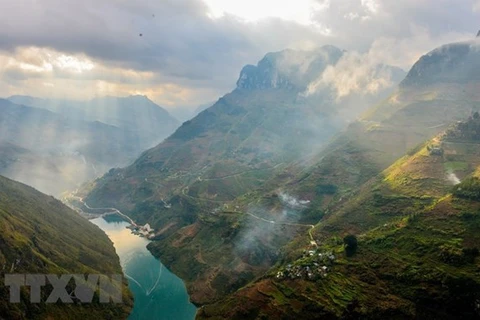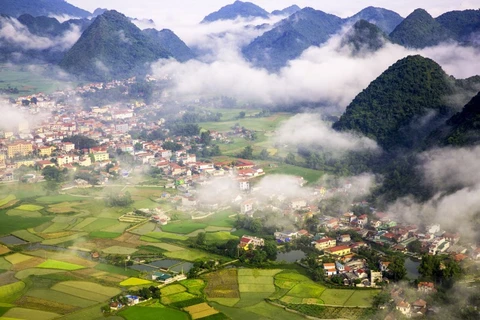
Hanoi (VNA) – Dak Nong Geopark, in the Central Highlands province of Dak Nong has been validated as a member of UNESCO Global Geoparks Network for another four years, from 2024 to 2027.
The decision was approved by the UNESCO Global Geopark Council within the framework of the 10th International Conference on UNESCO Global Geoparks held in Morocco last year, and the province was officially informed on the decision on July 1.
The certificate will be granted to the province at the 8th Asia Pacific Geoparks Network Symposium, scheduled to take place in September this year in the northern province of Cao Bang.
The revalidation reflects Dak Nong’s efforts to protect and promote the values of the geopark and offers an opportunity to attract resources for the province’s sustainable socio-economic development.
The Dak Nong Geopark was recognised by UNESCO as a global geopark in July 2020, becoming the third to obtain this title in Vietnam, after Dong Van Karst Plateau Geopark in Ha Giang and the Non Nuoc Cao Bang Geopark in Cao Bang.
It covers more than 4,700 sq.km, stretching through six districts and cities, namely Krong No, Cu Jut, Dak Mil, Dak Song, Dak G’Long, and Gia Nghia, equivalent to two-fifths of the province’s total area.
The geopark is home to 65 geological and geomorphologic heritage sites, including a system of nearly 50 caves with a total length of more than 10,000 metres, craters, and waterfalls.
With tropical forest ecosystem, the geopark holds typical biodiversity values. This land also preserves many unique cultural, geological, and natural features as well as traces of prehistoric activities.
The history of this land goes back 140 million years ago, when it was part of the ocean with traces found such as sedimentary rocks, ammonite fossil and other fossils. The tectonic movement of the Earth's crust caused this area to raise and volcanic appearance. Volcanic eruptions covered half of the area with layers of basalt lava.
As a part of the poetic and majestic M'Nong plateau, the geopark is the convergence of typical geological, archaeological, and cultural and biodiversity values of the region.
The most special feature in the Dak Nong Geopark area is the cave system in basalt rock located in the Dray Sap-Chu R'Luh area, which was discovered in 2007. This volcanic cave system has been recorded as the longest one in the Southeast Asian by the Japan Volcanic Cave Association in terms of scale, length and uniqueness. These caves still contain many secrets about formation mechanisms, mineral complexes, biodiversity and archaeological sites.
In the geopark’s area, there is also ancient geological heritage such as fossils of ammonites; natural lakes like Ea Sno, West Lake and a system of beautiful and majestic waterfalls like Gia Long, Trinh Nu and Dray Sap.
In addition, it also boasts a variety of bauxite, antimony, tin placer deposits, puzzolite and precious stone mines, especially opal – chalcedon semi-precious stones in large size.
The archaeological findings of prehistoric people in the volcanic cave area of the geopark have attracted the attention of domestic and foreign researchers and visitors.
Initial research results along with the finding of archaeological artifacts at great density, suggested that the area is a cultural vestige of the Late Stone Age and Early Metal Age dating back to 6,000-3,000 years ago. The findings included stone tools such as stoneware, dish-shaped tools and short axes. Animal bones, fragments and prehistoric human bones were also found.
Regarding ceramics, there are many types of items, with different thicknesses and thinness, made from sandy clay. The patterns on the ceramic pieces are quite sharp and diverse such as dots and dashes, and rope patterns.

Besides, the geopark is home to tangible and intangible cultural values, in particular the UNESCO-recognised “Gong Culture Space” intangible heritage and the Ho Chi Minh Trail special national relic.
Visitors to the geopark can also experience the diverse spiritual life of local ethnic groups, reflected through folk beliefs, rituals and folk art which should be well preserved and promoted.
Nam Nung Nature Reserve, Ta Dung National Park, Dray Sap special-use forest and a southern part of Yok Don National Park in Ea Po commune, Cu Jut district are the places where the biodiversity values of the park are kept.
The flora and fauna system in the geopark is diverse with many rare species, listed in Vietnam and the world's red books such as elephants, tigers, bison and some types of primates, namely vooc den ma trang (Trachypithecus francoisi), cha va chan den (Pygathrix nigripes), reptile, chim Hong Hoang (Great Hornbill) and ga tien mat do (Germain’s Peacock Pheasant). This is great potential for it to develop eco-tourism and biodiversity research, attracting scientists as well as domestic and foreign tourists to visit and study.
With the above typical values, it cannot be denied that Dak Nong geopark is an invaluable property of not only Dak Nong but also Vietnam and humankind as a whole. Therefore, winning the title of UNESCO Global Geopark for Dak Nong Geopark is a right move of the province to preserve and promote heritage values while contributing to boost socio-economic sustainable development./.






















